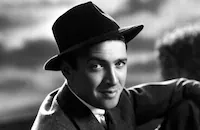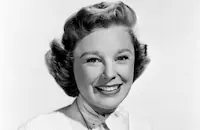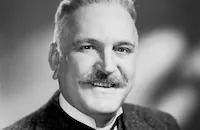The Stratton Story

Brief Synopsis
Cast & Crew
Sam Wood
James Stewart
June Allyson
Frank Morgan
Agnes Moorehead
Bill Williams
Film Details
Technical Specs

Synopsis
During the early 1900s, young Texan Monty Stratton walks ten miles to pitch for the Wagner Wild Cats baseball team, then walks home and works on his farm for the rest of the day. Hobo ex-catcher Barney Wile spots Monty playing his usual flawless game, and convinces him that, with the correct training, he could be major league material. Barney moves in with Monty and trains him throughout the winter, after which he finagles a tryout with Chicago White Sox manager Jimmy Dykes. Although Jimmy is initially reluctant, Monty's amazing speed and accuracy impress him, and he lets the boy stay with the Sox. As Monty tries to learn his way around the big city, he is overjoyed when fellow teammate Eddie Dibson invites him on a double date. Monty realizes Eddie is a cad, however, when he tries to steal Monty's date, the lovely and sophisticated Ethel, and leaves Monty with the whole tab. Monty grabs Ethel and leaves, quickly winning her over with his sincerity and sweetness. The White Sox soon hire Monty, and after sitting on the bench for most of the first season, he is finally allowed to pitch, but only against the powerhouse Yankees. The rookie gets beaten so badly that he is sent back to the White Sox training ground in Omaha. There, he calls Ethel to tells her that he loves her, but wants a chance to prove himself professionally before marrying. After great success in Omaha, Monty is asked to join the majors again, at which point he and Ethel marry. Forhis first outing, he is asked to pitch against the Yankees again, but this time he masters his fear and wins the game. When the season ends, he brings Ethel to his family farm to meet his mother and stay for the winter. The next spring, he wins every game he plays, and, during one game, learns while on the mound that Ethel has given birth to a boy, Monty, Jr. Within months, he is part of the All-Stars team and breaking league records, but Ethel worries that he is spending too much time out of the house. Soon, however, he takes her to a nightclub and reveals that he has spent his extra time learning how to dance in order to please her, and they dance all night. Months later, Monty is hunting rabbits when he stumbles and his gun discharges into his leg. Ethel finds him, but not soon enough to rescue his infected leg, which has to be amputated. After the operation, Monty feels useless and despondent and refuses to try to recover. For months he sits, motionless and bitter, as Ethel waits patiently for him to re-gather his resolve. Finally, however, Monty witnesses Junior taking his first steps, and realizes that he has been indulging in self-pity. As he apologizes for his frustration, Ethel assures him that he is the same person inside. Soon, Monty decides to learn to walk on his false leg, and within months he is tossing a baseball with Ethel, who reveals that she is expecting another baby. When Barney visits that spring, they all attend the All-Stars game, and are shocked to discover that Monty has convinced the coach to let him pitch. Although he is frightened and has trouble running and catching bunts, he overcomes all obstacles and wins the game for the Southern League. Money then goes on to play, and win, many games during the rest of his career.

Director

Sam Wood
Cast

James Stewart

June Allyson

Frank Morgan

Agnes Moorehead

Bill Williams
Bruce Cowling
Cliff Clark
Mary Lawrence
Dean White
Robert Gist
Gene Bearden
Bill Dickey
Jimmy Dykes
Mervyn Shea
Mitchell Lewis
Michael Ross
James Nolan
Peter Crouse
Florence Lake

Anne Nagel
Barbara Wooddell
Alphonse Martel

Holmes Herbert
Robert Graham
Eugene Persson
Lee Tung Foo
Ralph Littlefield
Charles B. Smith
Syd Saylor
George Melford
George Ovey
William Norton Bailey
Cy Stevens
Polly Bailey
Vangie Beilby
Mabel Smaney
Jessie Arnold
Al Rosen
Jim Drum
Charles Sullivan
Clarence Hennecke

Kenneth Tobey
Roy Partee
Pat Flaherty
Fred Millican
John "red" Burger
Brick Sullivan
Mike Pat Donovan
Pat Orr
John "ziggy" Sears
Jack Powell
Joe Rue
Fred Somers
William Hall
John Hiestand
Wesley Hopper
Carl Saxe
Karl Johnson
Jack Worth
Dwight Adams
George Vico
Louie Norikoff
James Gladd
Leonard Perme
Gerald Priddy
Harry Lowrey
Robert H. Sturgeon
Henry Sauer
William White
Allen Zarilla

John Kerr
John Warner
Golden Holt
Walter Berger
William Garbe
Jack Lohrke
Bryan Stephens
Don Heffner
Roy Hughes
Jess Dobernic
Cecil Garriott
Clarence Maddern
Alfred Stringer
Wally Hood
William Lillie
Maurice Kraft
Gene Mauch
Tuck Stainback
Jack Brewer
Ralph Kress
Larry Ward
Al Spaeter
Don Tierney
Al Lyons
Bud Beringhele
Al Porto
Edward Steward
Steve Mesner
John Lindell
John Bero
Edward Bockman
Kenneth Richardson
Morey J. Kaplan
Mickey Mccardle
William Allington
Gordon Ford
Ira Gordon
Al Mutart
George Woods
Charles Stevens
Lou Stringer
Frank Kelleher
Max West
Don Ross
Gus Zernial
Todd Davis
Clint Cameron
Al Treichel
Glen Russell
Cyril Moran
George Metkovich
Merle Combs
Crew
Peter Ballbusch
Jack Cummings
Jack Dawn
Adolph Deutsch
Dave Friedman
Cedric Gibbons
A. Arnold Gillespie
Paul Groesse
Sydney Guilaroff
Ralph S. Hurst
Lloyd Isbell
Ben Lewis
S. C. Manatt
Robert Martin
Les Martinson
Earl Mcevoy
Douglas Morrow
Douglas Morrow
Warren Newcombe
Helen Rose
Harold Rosson
Douglas Shearer
Sid Sidman
Monty Stratton
Guy Trosper
Charles E. Wallace
George Wells
Edwin B. Willis
Sam Wood

Photo Collections
Videos
Movie Clip



Film Details
Technical Specs

Award Wins
Best Writing, Screenplay
Articles
The Stratton Story
Over the course of the next several years, Stratton gained enough facility maneuvering on an artificial limb that he was willing to attempt a career comeback. In 1946, he accepted an invitation to play in the East Texas League, and proceeded to win 18 games that summer. When approached by MGM to option his story, the ballplayer initially demurred, but reconsidered when the studio talked about the inspiration it would grant disabled veterans of WWII who were struggling to deal with their circumstances. The end result of Hollywood's labors, The Stratton Story (1949), was a major hit in its day and remains one of the screen's most compelling sports biographies.
When the originally slated Van Johnson vacated the title role, and Gregory Peck subsequently passed, MGM turned to James Stewart, who was in fact Stratton's own preference to portray the pitcher. As recounted in Jhan Robbins' Everybody's Man: A Biography of Jimmy Stewart, the athlete knew his instincts were correct when he first screened the film: "When I saw Jimmy on the screen, I wept. He was more me than I am!"
Douglas Morrow's Oscar-winning screen story took its share of dramatic license with the facts of Stratton's odyssey, but the results are no less satisfying for it. The film opens on Barney Wile (Frank Morgan), an ex-big leaguer reduced to riding the boxcars, stumbling upon a semi-pro game where the young pitcher handily dominates his opposition. Recognizing Monty's potential, Wile insinuates himself into the aspiring pro's life, agreeing to help work the Stratton homestead while spending his off-hours honing the hurler's skills.
Monty's loving but pragmatic mother (Agnes Moorehead) finds his ambitions a waste of time, but ultimately gives her blessing once Wile deems him ready to crash the White Sox' spring training camp in California. Stratton's arm is sufficient to wear down the skepticism of ChiSox manager Jimmy Dykes (cast as himself) and earn a contract. In the course of that first pre-season, the shy prospect found himself roped into a disastrous double date with a pretty visitor from Omaha named Ethel Milberger (June Allyson). Regardless, the two ultimately click, and marry once Stratton makes the majors to stay.
From there, The Stratton Story follows the pitcher's emergence as an All-Star up until his fateful accident, as well as a descent into self-pity that his wife and mother were frustratingly powerless to curb. After watching his infant son take his first steps, Stratton makes the choice to use and master his prosthesis, and determinedly takes the mound in the comeback exhibition that exhilaratingly caps the film.
Stewart's preparation for his role was painstaking in many senses of the term. He spent three months consulting with Stratton, and put in five hours a day with various big leaguers perfecting his form. The results are evident in the game sequences of The Stratton Story, where he is utterly credible on the mound and at the plate. Further, beyond researching with physical therapists and orthopedists, the actor donned a steel harness which forced a limp.
Stewart found an ideal complement in the homespun wholesomeness of Allyson, and while directors and cameramen would always have a challenge resolving their 14" height differential, appreciative audiences returned to see them team in The Glenn Miller Story (1953) and Strategic Air Command (1955). The Stratton Story marked the final directorial credit for the dependable studio veteran Sam Wood, whose distinguished resume included another foremost baseball biodrama, The Pride of the Yankees (1942). In addition to Dykes, the film also cast major leaguers like Bill Dickey and Gene Bearden to heighten the authentic feel.
Fittingly, just as its protagonist defied all the naysayers, The Stratton Story turned on the conventional wisdom about sports movies being box-office poison and knocked it out of the park, becoming the sixth-biggest theatrical draw of 1949 and Stewart's first bona fide hit since his return from World War II.
Producer: Jack Cummings
Director: Sam Wood
Screenplay: Douglas Morrow, Guy Trosper
Art Direction: Cedric Gibbons, Paul Groesse
Cinematography: Harold Rosson
Editing: Ben Lewis
Cast: James Stewart (Monty Stratton), June Allyson (Ethel Stratton), Frank Morgan (Barney Wile), Agnes Moorehead (Ma Stratton), Bill Williams (Eddie Dilson), Bruce Cowling (Ted Lyons), Cliff Clark (Josh Higgins).
BW-107m. Closed captioning.
by Jay Steinberg

The Stratton Story
Kenneth Tobey (1917-2003)
Born in Oakland, California on March 23, 1917, Tobey originally intended to be a lawyer before a stint with the University of California Little Theater changed his mind. From there, he went straight to New York and spent nearly two years studying acting at the Neighborhood Playhouse, where his classmates included Gregory Peck, Eli Wallach and Tony Randall. Throughout the '40s, Tobey acted on Broadway and in stock before relocating to Hollywood. Once there, Tobey soon found himself playing a tough soldier in films like I Was a Male War Bride and Twelve O' Clock High (both 1949); or a tough police officer in Kiss Tomorrow Goodbye and Three Secrets (both 1950). Such roles were hardly surprising, given Tobey's craggy features, unsmiling countenance and rough voice.
Needless to say, no-nonsense, authority figures would be Tobey's calling for the remainder of his career; yet given the right role, he had the talent to make it memorable: the smart, likeable Captain Hendrey in The Thing From Another World (1951); the gallant Colonel Jack Evans in the "prehistoric dinosaur attacks an urban center" genre chiller The Beast from 20,000 Fathoms (1953, a must-see film for fans of special effects wizard, Ray Harryhausen; and as Bat Masterson, holding his own against Kirk Douglas and Burt Lancaster in Gunfight at the O.K. Corral (1957).
Television would also offer Tobey much work: he had his own action series as chopper pilot Chuck Martin in Whirlybirds (1957-59); and had a recurring role as Assistant District Attorney Alvin in Perry Mason (1957-66). He would also be kept busy with guest appearances in countless westerns (Gunsmoke, Bonanza, The Virginian) and cop shows (The Rockford Files, Barnaby Jones, Ironside) for the next two decades. Most amusingly, the tail end of Tobey's career saw some self-deprecating cameo spots in such contemporary shockers as The Howling (1981); Strange Invaders (1983) and his role reprisal of Captain Hendry in The Attack of the B-Movie Monsters (2002). Tobey is survived by a daughter, two stepchildren, and two grandchildren.
by Michael T. Toole
Kenneth Tobey (1917-2003)
Quotes
Trivia
Notes
The working title of this film was The Life of Monte Stratton. Stratton, who was born in Celeste, TX, on May 21, 1912 and died in Greenville, TX, on September 29, 1982, was a pitcher for the Chicago White Sox baseball team between 1934 and 1938. As depicted in the film, Stratton continued playing baseball after the amputation of his right leg following a hunting accident. He won eighteen games playing on an artificial leg. Stratton served as a technical advisor on the film, and coached James Stewart on big league pitching.
In February 1948, Hollywood Reporter announced that Roy Rowland had been assigned to direct the film. According to Hollywood Reporter, Rowland shot footage of the White Sox in Chicago in June 1948, before principal production on the film began, but the extent of his contribution to the final film has not been determined. A December 1947 Hollywood Reporter news item noted that Gregory Peck was considered for the title role. Van Johnson was announced for the role in March 1948, but Johnson, who had been severly injured in a 1943 automobile crash, withdrew from the cast after being advised by his physician that the role would be too strenuous for him. According to a September 1948 Daily Variety news item, Donna Reed was considered for the part played by June Allyson.
While various contemporary news items stated that Ted Lyons, the manager of the White Sox in 1948, was set to play himself in the film, he was portrayed by Bruce Cowling. Several real-life baseball figures did portray themselves in the film, including Jimmy Dykes, a former manager of the White Sox, and Cleveland baseball player Gene Bearden. Studio publicity materials claim that the picture featured seventy-two real-life professional baseball players representing all but two of the major league teams. Agnes Moorehead and Robert Gist, who both appeared in the film, were married from 1953 to 1958.
The baseball scenes were filmed at Wrigley Field in Chicago and Gilmore Field in Hollywood, and at American League fields in Chicago, Cleveland, Detroit and Washington, D.C. The April 21, 1949 world premiere of The Stratton Story in Cleveland, OH, was held in honor of the Cleveland Indians' opening home game of the season. An M-G-M Silver Anniversary gala showing of the film was held in Los Angeles on June 1, 1949. During the spring of 1949, the film played in selected cities with American League teams before its general release in June 1949. The Stratton Story won an Academy Award for Best Motion Picture Story. In February 1950, the film was named the "most enjoyed motion picture of 1949" by Photoplay magazine, and received six of the magazine's Gold Medal Awards. The film was also named Picture of the Year by the Protestant Motion Picture Council and the Christian Herald. Modern sources indicate that the film grossed $3,700,000 in its initial release. Stewart and Allyson recreated their roles for a Lux Radio Theatre broadcast of the story on February 13, 1950.














